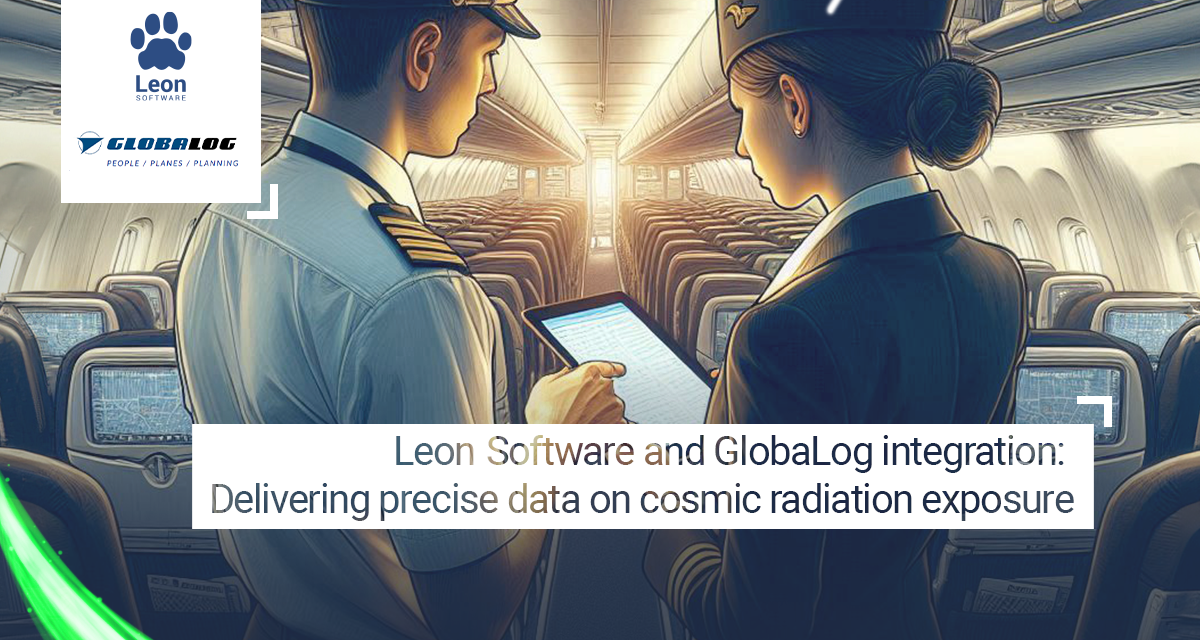Leon Software and GlobaLog integration: Delivering precise data on cosmic radiation exposure
GlobaLog's integration with Leon Software efficiently delivers precise data on cosmic radiation exposure, essential for airline operators to meet regulatory requirements. By accessing detailed flight and crew information from Leon Software, including departure, arrival, and aircraft type, GlobaLog accurately calculates radiation exposure, enhancing crew safety and ensuring compliance with international standards.

Understanding Cosmic Radiation Exposure in Aviation
We are all exposed to cosmic radiation daily, as flight crew you are more at risk from over exposure to cosmic radiation: The dose of radiation at the cruising altitude of airlines is between 60 and 200 times greater than at sea level. Each flight is different, time, date, route, the cosmic radiation dose varies due to the protection from atmosphere, there is less protection by the poles. The three main factors that can affect the amount of exposure to cosmic radiation:
Altitude: the higher we go, the greater the dose
Latitude: the closer we get to the poles, the greater the dose
Duration: the longer we stay in the air, the greater the dose
Regulatory Compliance and the Need for Accurate Monitoring
A considerable number of Civil Aviation Authorities worldwide have implemented regulations similar to those set in EU Council Directive 2013/59/EURATOM for monitoring cosmic radiation. Each Member State shall make arrangements for parties operating aircraft to take account of exposure to cosmic radiation of air crew who are liable to be subject to an exposure of more than 1 milliSievert per year. The parties shall take appropriate measures, in particular:
- to assess the exposure of the crew concerned,
- to take into account the assessed exposure when organizing working schedules with a view to reducing the doses of highly exposed aircrew,
- to inform the workers concerned of the health risks their work involves.
Article 35, EU Council Directive 2013/59/EURATOM
An employer must ensure that the dose of cosmic radiation to a pregnant woman be as low as reasonably achievable and that it will be unlikely that this dose will exceed 1 mSv during at least the remainder of the pregnancy.
Article 10, EU Council Directive 2013/59/EURATOM
GlobaLog, an advanced system designed to manage and monitor cosmic radiation exposure for airline crew members, helps to meet these regulations. Utilizing data from multiple neutron monitoring stations around the world, it provides minute-by-minute calculations of radiation exposure based on real-time flight details such as altitude, position, and aircraft type. The system's integration with Leon Software allows it to automatically retrieve this data, ensuring high accuracy in its estimates.
Approved by several European authorities and CAA’s worldwide, GlobaLog is recognized for its precision and reliability in assessing radiation exposure, offering better protection for flight crews. The system not only records and tracks individual exposure levels but also generates comprehensive reports that are accessible to both crew members and airline administrators. This transparency ensures that all parties are aware of potential risks and can take proactive measures to mitigate them.
GlobaLog's Advanced System: A Leap Beyond Traditional Methods
GlobaLog is a significant improvement over previous methods that relied on average radiation values for monitoring exposure. Traditional methods calculated exposure using monthly averages, which could overlook short-term fluctuations in radiation levels, sometimes by a factor of 100 to 200 times. GlobaLog’s calculations are based on real-time data, ensuring that crew members receive accurate assessments of their radiation exposure for each flight.
With the rise of digitalization and advanced tools like Leon Software, aircraft operators and crew members now have daily access to the precise data needed to accurately estimate cosmic radiation exposure during specific flights. Leon Software serves as the central hub for all flight operations information, ensuring seamless and secure transfer of essential data to integrated systems like GlobaLog. This integration guarantees that radiation monitoring systems function effectively, providing accurate, real-time assessments to enhance safety and compliance in aviation operations.
Empowering Crew Safety with Real-Time Data
For pilots and cabin crew, GlobaLog enhances safety by providing detailed insights into their radiation exposure over time, allowing them to make informed decisions about their health and career. It also helps airlines comply with international radiation exposure regulations, which require documentation and monitoring of radiation doses to ensure they remain within safe limits.
Data from the system can also be used in scientific studies to better understand the long-term effects of cosmic radiation, further contributing to the safety and well-being of aviation professionals.
About Global Aviation Data A/S
Global Aviation Data A/S is a Danish company specializing in the management and monitoring of cosmic radiation exposure in the aviation industry. Founded with support from the Danish Ministry of Science, Technology, and Innovation, the GlobaLog system was developed in collaboration with prominent institutions like the Federal Aviation Administration (FAA) and the Danish Space Research Institute, endorsed the mathematical basis and methodology of the calculations for the system. Their flagship product, GlobaLog®, is widely recognized for its accuracy in calculating radiation exposure, helping airlines comply with international regulations and ensuring the safety of flight crews.
Not yet a member of Leon community? Contact our Sales team to find out more or jump straight into the 30-day free trial.
TAGGED WITH



